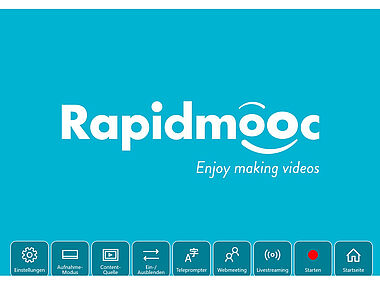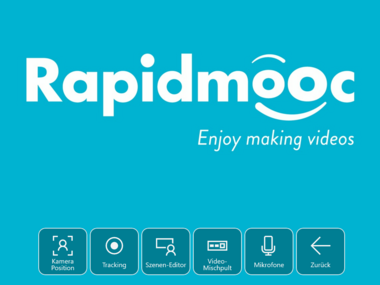Options in the video menu
RMOOC 20-030
What you need to know
Once you have selected the "Video aufzeichnen" (Record video) tile in the main menu, you will enter the options. This guide will take you through the most important configurations you can make in the options.
For control you can use the touchscreen directly on the Rapidmooc as well as the wireless keyboard (via trackpad).
What you have to do
Select the "Video aufzeichnen" (Record video) tile in the main menu.
Various options open.
- 1.1

Options in Rapidmooc
Recording mode: Use the wireless keypad to select the recording mode first (bottom left) and select "Green Screen" (top left).
There are seven different video mode settings available. Use "Green Screen" to fade in before the slides.
All other video modes also film the room setting (in our case the green screen) or only the slides (screencast).
Green Screen
The green screen is completely replaced by the presentation/a background image. The speaker is inserted in front of it.
With the "Augmented Reality" recording mode you can, for example, if you work in your slides with a green background, fade in (a sort of "free-floating" effect) illustrations and diagrams in the room setting. An example presentation can be found in the corresponding FELIX group.
If you have selected a recording mode, then click on "Einstellungen" (settings).
As shown in Figure 3.1, you can configure various settings.
For those new to "Rapidmooc" it is highly recommended to configure the camera position and to use the scene editor.
Camera position: Here you can control the camera orientation with the arrow keys and change your speaker size by zooming in and out. The "Autofokus" (autofocus) function should only be deactivated if necessary.
Caution: Do not steer beyond the frame of the green screen. If you are not happy with your position on the screen, you can still adjust it afterwards in the scene editor.
You can also define presets and switch between them during your presentation. Please refer to Helpcard Internal link opens in the same window:Selecting camera settings (RMOOC 30-010) for more information.
Scene editor: The Scene editor allows you to "stage" not only yourself, but also your slides and another background image together as you wish. This is particularly recommended if you have not necessarily left room in your slides for you as the speaker. Follow Helpcard Internal link opens in the same window:The scene editor (RMOOC 20-035). (from step 2).
Greenscreen: If you select the "Greenscreen" recording mode, you can adjust the quality of the greenscreen overlay via the slider. We recommend manual adjustment first, if necessary.
Manual adjustment:
Here you can configure the foreground, background and border (e.g. fine-tune the edge of the hairstyle).
Guide values are: Foreground 15%, Background: 50%, Edge: between 98 and 100%.
Tip: The configuration is important for blonde hair, here you can achieve a better result with a minimal increase in the foreground.
You can make an automatic adjustment by unplugging the laptop, going out of the image and then pressing "Green Screens definieren" (define greenscreen hue). Wait until the button is green, then the process is complete.
Video mixer: It is possible to connect a secondary camera or the integrated webcam of the laptop.
Microphones:
If you have connected another microphone, you can activate it here - for example, if you have integrated a video in a presentation and want to play it ("Mikrofon 3").
You can also set the volume of the microphone here.
- 3.1

Configure settings
Press "Zurück" to go back to the "Video aufzeichnen" (record video) menu.
Fade in/out: Click on Show/Hide to hide the camera image during recording and click again to show it again.
This option is especially useful if you would cover content on the slides.
Teleprompter: This option is only relevant if you want to use the teleprompter. More info on this on Helpcard Internal link opens in the same window:Using the teleprompter (RMOOC 30-030).
Helpcard Internal link opens in the same window:Starting and finishing a video recording (RMOOC 20-040) shows you how to start a recording.